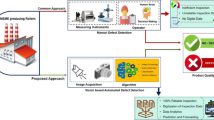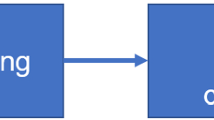Abstract
In modern manufacturing, accurate and efficient assessment of surface finish quality is vital to product integrity within mechanical systems and contribution to its overall performance. For this reason, the present study proposes an intelligent system based on deep learning and computer vision to evaluate the surface roughness of machined steel mechanical parts. In this context, two popular deep learning architectures designed for object detection tasks, namely, Faster R-CNN Inception v2 and Faster R-CNN ResNet50, are used to train and evaluate an automatic detection model at this purpose. The obtained results demonstrate the potential of the proposed hybrid technique and its advantages related to other technique for rapid, accurate, and real-time assessment of surface roughness. Additionally, the model trained using Faster R-CNN Inception v2 emerges as the preferred choice based on the evaluation results in terms of detection accuracy and calculation speed during the training phase. Finally, this article proposes improvements to be made to the model with the aim of its integration into the production process for both offline and online product quality control to ensure intelligent, profitable, and sustainable production.






Similar content being viewed by others
References
Schirripa Spagnolo G, Cozzella L, Leccese F (2014) Viability of an optoelectronic system for real time roughness measurement. Measurement 58:537–543. https://doi.org/10.1016/j.measurement.2014.09.018
Santos PMD, Júlio ENBS (2013) A state-of-the-art review on roughness quantification methods for concrete surfaces. Constr Build Mater 38:912–923. https://doi.org/10.1016/j.conbuildmat.2012.09.045
Tonietto L, Gonzaga L, Veronez MR, Kazmierczak CDS, Arnold DCM, Costa CAD (2019) New method for evaluating surface roughness parameters acquired by laser scanning. Sci Rep 9(1):15038. https://doi.org/10.1038/s41598-019-51545-7
Lyukshin V, Shatko D, Strelnikov P (2021) Methods and approaches to the surface roughness assessment. Mater Today Proc 38:1441–1444. https://doi.org/10.1016/j.matpr.2020.08.122
Manjunath K, Tewary S, Khatri N (2022) Surface roughness prediction in milling using long-short term memory modelling. Mater Today Proc 64:1300–1304. https://doi.org/10.1016/j.matpr.2022.04.126
Jinlong W, Yuxin M, Wenjie P, Yongjie B, Zeyu S (2023) Evaluation of the effect of surface roughness parameters on fatigue of TC17 titanium alloy impeller using machine learning algorithm and finite element analysis. Eng Fail Anal 153:107586. https://doi.org/10.1016/j.engfailanal.2023.107586
Liu C, Huang Z, Huang S, He Y, Yang Z, Tuo J (2023) Surface roughness prediction in ball screw whirlwind milling considering elastic-plastic deformation caused by cutting force: modelling and verification. Measurement 220:113365. https://doi.org/10.1016/j.measurement.2023.113365
Zhang T, Yuan L (2022) Understanding surface roughness on vertical surfaces of 316 L stainless steel in laser powder bed fusion additive manufacturing. Powder Technol 411:117957. https://doi.org/10.1016/j.powtec.2022.117957
Chiu M-C, Tsai H-Y, Chiu J-E (2022) A novel directional object detection method for piled objects using a hybrid region-based convolutional neural network. Adv Eng Inform 51:101448. https://doi.org/10.1016/j.aei.2021.101448
Misaka T, Herwan J, Ogura I, Furukawa Y (2021) Turning process monitoring with deep neural network trained by FEM simulation. Procedia CIRP 104:376–380. https://doi.org/10.1016/j.procir.2021.11.063
Zhang Y, Shan S, Frumosu FD, Calaon M, Yang W, Liu Y, Hansen HN (2022) Automated vision-based inspection of mould and part quality in soft tooling injection moulding using imaging and deep learning. CIRP Ann 71(1):429–432. https://doi.org/10.1016/j.cirp.2022.04.022
Yang J, Zou B, Guo G, Chen W, Wang X, Zhang K (2022) A study on the roughness detection for machined surface covered with chips based on deep learning. J Manuf Process 84:77–87. https://doi.org/10.1016/j.jmapro.2022.09.061
Zhang H, Wu S, Zhang Z, Han L (2023) Rock joint roughness determination method based on deep learning of time–frequency spectrogram. Eng Appl Artif Intell 117:105505. https://doi.org/10.1016/j.engappai.2022.105505
Wang R, Cheng MN, Loh YM, Wang C, Fai Cheung C (2022) Ensemble learning with a genetic algorithm for surface roughness prediction in multi-jet polishing. Expert Syst Appl 207:118024. https://doi.org/10.1016/j.eswa.2022.118024
Muthuram N, Frank FC (2021) Optimization of machining parameters using artificial intelligence techniques. 3rd International Conference on Materials. Manuf Model 46:8097–8102. https://doi.org/10.1016/j.matpr.2021.03.045
Möhring H-C, Eschelbacher S, Georgi P (2021) Machine learning approaches for real-time monitoring and evaluation of surface roughness using a sensory milling tool. 18th CIRP Conference on Modeling of Machining Operations (CMMO), Ljubljana, Slovenia, June 15–17, 2021, 102, 264–269. https://doi.org/10.1016/j.procir.2021.09.045
Hashmi AW, Mali HS, Meena A, Khilji IA, Hashmi MF, Saffe SN, Binti M (2022) Artificial intelligence techniques for implementation of intelligent machining. Int Conf Appl Res Eng 2021 56:1947–1955. https://doi.org/10.1016/j.matpr.2021.11.277
Bakhtiyari AN, Wang Z, Wang L, Zheng H (2021) A review on applications of artificial intelligence in modeling and optimization of laser beam machining. Opt Laser Technol 135:106721. https://doi.org/10.1016/j.optlastec.2020.106721
Soori M, Arezoo B, Dastres R (2023) Machine learning and artificial intelligence in CNC machine tools, a review. Sustain Manuf Serv Econ 100009. https://doi.org/10.1016/j.smse.2023.100009
Motta MP, Pelaingre C, Delamézière A, Ayed LB, Barlier C (2022) Machine learning models for surface roughness monitoring in machining operations. 6th CIRP Conf Surf Integr 108:710–715. https://doi.org/10.1016/j.procir.2022.03.110
Boga C, Koroglu T (2021) Proper estimation of surface roughness using hybrid intelligence based on artificial neural network and genetic algorithm. J Manuf Process 70:560–569. https://doi.org/10.1016/j.jmapro.2021.08.062
Cheng M, Jiao L, Yan P, Li S, Dai Z, Qiu T, Wang X (2022) Prediction and evaluation of surface roughness with hybrid kernel extreme learning machine and monitored tool wear. J Manuf Process 84:1541–1556. https://doi.org/10.1016/j.jmapro.2022.10.072
Varol Ozkavak H, Sofu MM, Duman B, Bacak S (2021) Estimating surface roughness for different EDM processing parameters on Inconel 718 using GEP and ANN. CIRP J Manuf Sci Technol 33:306–314. https://doi.org/10.1016/j.cirpj.2021.04.007
Acknowledgements
We would like to acknowledge all responsible of plastic department in LAK school for providing the materials, machine, and instruments used in this paper.
Author information
Authors and Affiliations
Contributions
This paper is mainly the work of the author Mr. EL G.M. under the supervision of two other people who are the thesis director Mr. M.A. and his co-director Mr. M.R. who participated in the supervision, orientation and discussion of the work.
Corresponding author
Ethics declarations
Conflict of interest
The authors declare no competing interests.
Additional information
Publisher's Note
Springer Nature remains neutral with regard to jurisdictional claims in published maps and institutional affiliations.
Replication of results
The main data used are presented in article. But, upon reasonable request, the authors are willing to share the all additional data and code request to generate the results in this paper.
Rights and permissions
Springer Nature or its licensor (e.g. a society or other partner) holds exclusive rights to this article under a publishing agreement with the author(s) or other rightsholder(s); author self-archiving of the accepted manuscript version of this article is solely governed by the terms of such publishing agreement and applicable law.
About this article
Cite this article
EL Ghadoui, M., Mouchtachi, A. & Majdoul, R. Intelligent surface roughness measurement using deep learning and computer vision: a promising approach for manufacturing quality control. Int J Adv Manuf Technol 129, 3261–3268 (2023). https://doi.org/10.1007/s00170-023-12457-z
Received:
Accepted:
Published:
Issue Date:
DOI: https://doi.org/10.1007/s00170-023-12457-z




